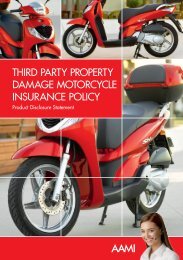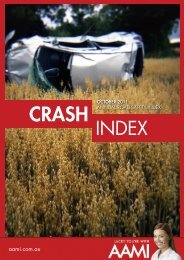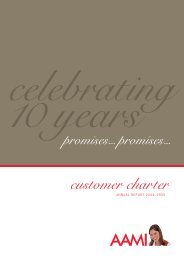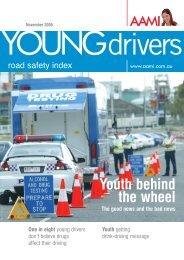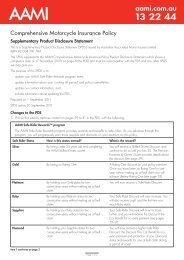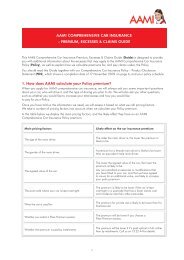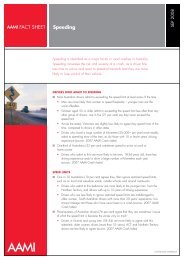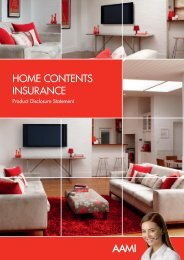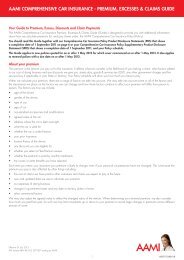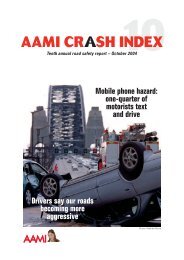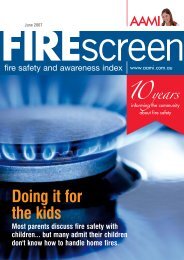HOME BUILDING INSURANCE Product Disclosure Statement - AAMI
HOME BUILDING INSURANCE Product Disclosure Statement - AAMI
HOME BUILDING INSURANCE Product Disclosure Statement - AAMI
- No tags were found...
You also want an ePaper? Increase the reach of your titles
YUMPU automatically turns print PDFs into web optimized ePapers that Google loves.
<strong>HOME</strong> <strong>BUILDING</strong><strong>INSURANCE</strong><strong>Product</strong> <strong>Disclosure</strong> <strong>Statement</strong>
PDS dated 09/11/112
ContentsIntroduction 4Your <strong>AAMI</strong> <strong>Product</strong> <strong>Disclosure</strong> <strong>Statement</strong> 4Summary of insured events 6Summary of important claims information 8Peace of mind with <strong>AAMI</strong> 9About your premium 9About our fees 10Paying your premium 10Your responsibilities 12When you need to contact us 13About your cover 14Who we cover - You/Your 14Where we cover - the insured address 14What we cover - the building 15What we do not cover as - the building 16The most we will pay for building claims 16What you are covered for - Insured Events 16Additional features 26Additional cover 28Legal Liability 30What we do not cover - general exclusions 32Claims 37Making a claim 37How to establish your loss 39Your excess 40How we settle building claims 41What happens after a claim is paid 48Other Important Information 49What happens with cancellations? 49What do we mean by that? 50How we will deal with a complaint 54Report insurance fraud 56General Insurance Code of Practice 56Financial Claims Scheme 563
IntroductionYour <strong>AAMI</strong> <strong>Product</strong> <strong>Disclosure</strong> <strong>Statement</strong>Why is this document important?This <strong>Product</strong> <strong>Disclosure</strong> <strong>Statement</strong> (PDS) is an important legal document that contains details of your<strong>AAMI</strong> Home Building Insurance if you purchase this product from us. Before you decide to buy thisproduct from us, please read this PDS carefully. If you purchase this product, your policy comprises ofthis PDS and your insurance schedule which shows the details particular to you.The information in this PDS was current at the date of preparation. We may update some of theinformation in the PDS that is not materially adverse from time to time without needing to notify you.You can obtain a copy of any updated information by contacting us on 13 22 44. We will giveyou a free paper copy of any updates if you request them. If it becomes necessary, we will issue aSupplementary <strong>Product</strong> <strong>Disclosure</strong> <strong>Statement</strong> (SPDS) or replacement PDS.Our commitment to youWhen you are an <strong>AAMI</strong> policyholder and you need to claim on your policy, our claims service willtake away the stress and hassle. We are here to help you 24 hours a day, every day of the year.Call us on 13 22 44.<strong>AAMI</strong>’s Customer CharterWe are committed to always provide you with the highest standard of service. The <strong>AAMI</strong> CustomerCharter is a written document containing service and reporting promises which we are bound to deliver.In fact, we impose a penalty on ourselves if we fail to do so.This unique Charter was drawn up through consultation with our staff, our customers and industryregulators. We are committed to keeping the promises we have made in this Customer Charter, and willreview them annually.The <strong>AAMI</strong> Customer Charter, introduced in 1996, was Australia’s first general insurance customer charterand indeed the first retail customer charter. The Charter is your guarantee that we’re always striving todeliver the best in customer service.Cooling off periodAfter this insurance begins or you renew your policy for another period of cover, you have 21 daysto consider the information in your PDS. This is called the ‘cooling off period’. If you decide to cancelyour policy during the cooling off period we will refund the unexpired portion of the total premium, lessany non refundable government charges, and less $30 of premium (plus government charges and fireservices levy if applicable) which we keep to cover our reasonable administrative and transaction costs.See page 49 for other times when you can cancel your policy.4
Who is this product designed for?This insurance product is specially designed to cover the buildings that you own and live in.This product does not cover the contents of any building.We rely on the accuracy of your informationWhen we agree to insure you, to renew or vary your policy, or to pay your claim, our decision relies onthe accuracy of the information you give us. If that information is not accurate, we can reduce or denyany claim you may make or cancel your policy. We never want to have to do that, so you must answerhonestly, correctly and completely the questions we ask about:• You;• the buildings;• any events that result in a claim on your <strong>AAMI</strong> policy.When you receive your renewal, please carefully check the information it shows about you and thebuildings. If any of that information is incorrect or incomplete, please call us on 13 22 44 and we willupdate our records.Joint policyholdersWhen you insure the building in the names of more than one person, each person is a joint policyholderand is able to make changes that we agree with to your policy. We will treat a statement, act, omission,claim or request to alter or cancel your policy made by one as coming from all those named as insuredon your insurance schedule.Some words in your policy have special meaningsSome words when used in this PDS have special meanings. Most of the words with special meaningsare defined in the ‘What do we mean by that’ section on page 50.5
Summary of insured eventsThis summary lists the insured events that we cover with an example of what we do not cover in relationto that insured event. This is a summary only and there are other things we do not cover. For full detailsof what we cover and do not cover you for, read your insurance schedule and the full PDS carefully,including pages 16 to 25, and in ‘What we do not cover - general exclusions’ on pages 32 to 36 ofthis PDS.FloodBut we do not cover loss or damage to retainingwalls, garden borders and free standing outdoorwalls.Important Note: We do not cover flood ifyou have asked to remove this insured eventfrom your policy (and we have agreed). Yourinsurance schedule will show that you do nothave flood cover.More details page 17LightningBut we do not cover loss or damage caused bypower failures or surges by your power provider.More details page 19EarthquakeBut we do not cover loss or damage that occursmore than 72 hours after the earthquake.We do not cover loss or damage caused byflood under this insured event.More details page 20Theft or BurglaryBut not loss or damage caused by someone whoentered the insured address with your consent.More details page 20StormBut we do not cover the cost of cleaning mud orclearing debris out of tanks, swimming pools orspas, including replacing or storing the water.We do not cover loss or damage caused byflood under this insured event.More details page 18FireBut we do not cover loss or damage to thebuilding arising from arcing, scorching orcigarette burns unless a fire spreads from theinitial burn spot.More details page 19TsunamiBut we do not cover loss or damage that occursmore than 72 hours after the tsunami.We do not cover loss or damage caused byflood under this insured event.More details page 20Accidental breakage of glassBut we do not cover any loss or damage if thebreakage does not extend through the entirethickness of the damaged item (e.g. chips orscratches).More details page 216
Escape of liquidBut we do not cover wear and tear, or lossor damage caused by the escape of liquidoccurring as a result of a gradual processof bursting, leaking, splashing, dripping oroverflowing over a period of time when youcould reasonably be expected to be aware ofthis condition.ImpactBut we do not cover the cost of removing orlopping fallen trees or branches that have notdamaged the building.We do not cover loss or damage caused byflood under this insured event.We do not cover loss or damage caused byflood under this insured event.More details page 22Damage by an animalBut we do not cover loss or damage caused byinsects, vermin or rodents (some limited exceptionsapply).More details page 23Riot, civil commotion or public disturbancesBut we do not cover loss or damage caused byyou or someone who lives at the insured address.More details page 24More details page 23ExplosionBut we do not cover the cost of repairing orreplacing the tank or container that exploded.More details page 24Malicious acts and vandalismBut we do not cover loss or damage caused byyou or someone who lives at the insured address.More details page 257
Summary of important claims informationThis summary lists some of the important information to consider when making a claim. This is a summaryonly and there are other things you should be aware of when making a claim.For more details see pages 37 to 48.Making a claimIt is important that you contact us as soon as possible after the loss or damage has occurred. You mustalso take reasonable steps to prevent further loss or damage.More details page 37Establishing your lossYou will need to prove that an incident covered by your policy has occurred and also the extent of theloss you have suffered.More details page 39Proof of ownership and valueWe may require proof of ownership in the event of a claim.More details page 39ExcessAn excess is the amount you ordinarily have to pay for each incident when you make a claim.The excess(es) that apply depend upon the circumstances of the claim.More details page 40How claims are settledDepending on the circumstances we will decide to repair, rebuild or pay you what it would cost us torepair or rebuild.More details page 418
Peace of mind with <strong>AAMI</strong>Complete Replacement Cover for the building<strong>AAMI</strong> home building insurance comes with Complete Replacement Cover.This means we cover loss or damage to the building due to an insured event up to whatever it costs us torepair or rebuild the building on a ‘new for old’ basis, unless provided otherwise in your policy.There are some limitations and conditions that apply to our Complete Replacement Cover. Please readthe entire PDS carefully particularly pages 41 to 46 so that you understand how we settle buildingclaims.About your premiumThe premium is the amount you pay us for this insurance and it includes stamp duty, GST, othergovernment charges and any fire services levy (FSL) that applies. The total amount due will be shown onthe documents given with your insurance schedule as the ‘Amount Due’ or, if you pay by instalments, theamount due each month will be shown on your insurance schedule as ‘Monthly Instalment’.In addition to the current cost of rebuilding the building, we use many factors about you and the buildingto work out your premium. These are called premium factors. The premium factors we use reflect thelikelihood of you making a claim together with other factors related to our cost of doing business.Each time you renew your insurance your premium is likely to change, even if your personalcircumstances have not changed. This is because premiums are affected by other things such as ourexpenses of doing business and changes in our approach to how we calculate your premium.Your premium includes any discounts we have given you.If you pay your premium by instalments it costs you more than if you choose to pay your premium in oneannual payment and this is factored in as part of our premium calculation.More DetailsFor further details on how we work out your premium, please refer to our Premiums, Excesses,Discounts and Claim Payments Guide available at aami.com.au. A copy of this guide can beprovided to you on request, at no charge, if you contact us on 13 22 44.9
About our feesCancellation feeWe incur costs in establishing and administeringyour policy. If you cancel your policy withinthe same period of cover, we might choose tocharge a cancellation fee.A cancellation fee will not apply if:• you are cancelling your policy which you payby instalments;• we cancel the cover for any reason.DetailsIf you cancel your policy we will refund theunexpired portion of the total premium less anynon refundable government charges and less$30 of premium (plus government charges andfire services levy if applicable) which we keepto cover our reasonable administrative andtransaction costs.If the refund due is less than the fee, a refundwill not be issued and we will not charge youan additional amount to cover the difference.Paying your premiumWe will tell you how much you have to pay and how much time you have for payment on yourinsurance schedule. You can pay in one annual payment or if we agree, by instalments.Unless we tell you, any payment reminder we send you does not change the expiry or due date. If youdo not pay the total amount due, we may reduce the period of cover so it is in line with the amount youpaid.If you make a change to your policy details it may affect the premium you need to pay for the remainderof your period of cover. If a refund of $10 or more is payable, we will send you a cheque or credit yourpayment card account.Late annual paymentsIf you do not pay the total amount due by the due date in the first year of insurance with us, we will giveyou a written notice of policy cancellation where we are required by law to do so.If you do not pay the total amount due on renewal by the due date, you will have no cover from thedue date.If we accept your late payment, we might recommence your cover from the date we receive yourpayment. If so, you will have no cover for the period from the due date until the date of payment.10
Overdue instalmentsIf you pay your premium by instalments and an instalment is overdue, we can do one or both ofthe following:• refuse to pay a claim if an instalment is 14 days (or more) overdue;• cancel your policy without notifying you in advance if an instalment is 1 month (or more) overdue.Important things to remember when paying by instalmentsIf we have agreed you can pay your premium by instalments:• you must be an authorised signatory on the account nominated for your instalment payments;• you must ensure that your nominated account has sufficient funds to meet each payment at eachdue date.Your financial institution may apply its own fees (including dishonour fees). Those fees are yourresponsibility.When you first commence paying by instalments, or when you change your account details, it may takeup to 14 days for us to take the first instalment payment.If you want to ask us to change or cancel your instalment payment arrangements, you need to contact usat least 7 days before the next instalment is due.If you want to cancel the instalment payment arrangements completely, you will need to contact us andmake alternative arrangements for payment of the total amount due for the rest of the period of cover.If you do not, you may not be covered.If you ever think we have made a mistake in relation to an instalment payment, please contact uson 13 22 44.More DetailsFor further details on how we work out your premium, please refer to our Premiums, Excesses,Discounts and Claim Payments Guide available at aami.com.au. A copy of this guide can beprovided to you on request, at no charge, if you contact us on 13 22 44.11
Your responsibilitiesYou must:• keep the building well maintained and in good condition. For what we mean by ‘good condition’see ‘What do we mean by that’ on page 51;• take reasonable care to prevent theft, loss, damage or legal liability;• follow all the terms and responsibilities set out in your policy;• provide honest and complete information for any claim, statement or document supplied to us;• ensure that the building complies with local government or other statutory requirements at all times.Not meeting your responsibilitiesIf you do not meet your responsibilities, it may lead us to do one or both of the following:• reduce or refuse to pay your claim;• cancel your insurance policy.When the building is unoccupied for more than 60 daysWe will apply the unoccupied excess to each incident covered by your policy unless your policy statesthat no excess applies to your claim if, at the time of the incident, the building has been unoccupied formore than 60 continuous days.A period of unoccupancy starts when the building becomes unoccupied and comes to an end whenyou, or someone nominated by you, has occupied the building for at least 2 consecutive nights. You maybe asked to prove the occupancy of the building in the event of a claim. This may be supported by theusage of the utilities that are connected to the building. Sometimes we might ask for other evidence ofoccupancy. We will decide if the unoccupied excess applies in this circumstance.If you have to pay the unoccupied excess it is payable in addition to any other excess that applies toyour claim. For more details about the unoccupied excess, see page 40.12
When you need to contact usYou must contact us when:• you start to operate or intend to operate a business activity at the insured address;• there are changes to any business activity you operate at the insured address, such as:– you change the type of business activity;– people start to come to the insured address;– you install business signage;– you need to store chemicals for the business activity;• any detail on your insurance schedule is no longer accurate, such as the insured address or thedescription of the building (if shown);• you purchase a new building;• you intend to demolish the building, have lodged an application to do this, or a government authorityhas issued a demolition order;• you move out and let the building to tenants;• trespassers (squatters) occupy the building;• you commence building or renovations at the insured address;• anything else happens that increases the chance that loss, damage or injury will occur at the insuredaddress.What we will do when you contact usWhen you contact us and tell us about these changes, we may decide to impose an additional excess,charge an additional premium or apply a special condition to your policy. In some cases, it could meanwe can no longer insure you and we will cancel your policy.13
About your coverWho we cover - You/YourYou/Your refers to the person or persons named as the insured on your insurance schedule and membersof your family who normally live with you at the insured address.If the insured shown on your insurance schedule is a company, trustee of a trust or Body Corporate, thenyou/your refers to:• that company, trustee or Body Corporate;• the following if they normally live at the insured address:– any company director, company owner or trust beneficiary; and– their respective family members.Family means:• your spouse, partner or de facto;• your parents, parents-in-law, grandparents;• your children, grandchildren, brothers and sisters, including their respective spouse,partner or de facto;• the children, parents, parents-in-law, grandparents, grandchildren, brothers and sisters of a spouse,partner or de facto; and• people who provide care or services to you.Where we cover - the insured addressWe cover the building at the insured address. The insured address is the address/location shown onyour insurance schedule. It also includes all land adjoining the insured address that you have a legalright to occupy, if the adjoining land is not subject to any communal or common property conditions(e.g. community title/strata title arrangements). The insured address does not include common property.14
What we cover – the buildingThe building that you own or are responsible for and use primarily for domestic purposes and describedas ‘the Building’ on your insurance schedule (if it shows a description of ‘the Building’) including thefollowing at the insured address:• garages, carports, outbuildings, outdoor walls, gates, fences and any structural improvementson land;• decks, pergolas, pagodas, verandas and balconies, fixed water tanks, fixed swimming pools andspas, granny flats, sheds and tennis courts;• garden borders, pathways, and paved or concreted floor areas;• driveways or sealed roads;• retaining walls;• services, both above and below ground that are your property and you are responsible for;• any permanently housed, connected or wired electrical appliances;• any permanently fixed outdoor items, including solar panels, satellite dish, play equipment,clothes lines, animal housing and outdoor lights;• gas appliances permanently plumbed to a gas supply;• any permanently attached fixtures including wall, ceiling and floor coverings;• lino that is installed, whether permanently attached or not;• sewer storage tanks or treatment tanks permanently plumbed to the building;• boat jetties, pontoons, mooring poles and their attachments and accessories which are locatedwithin the boundaries of the insured address or where part of their structure begins or terminates onthe insured address;• any uninstalled building fittings, fixtures and materials but only when kept in a locked and securedbuilding at the insured address.15
What we do not cover as - the buildingBuilding does not include:• anything defined as contents;• any new building in the course of construction;• any temporary or mobile structures, including caravans, houseboats, watercraft or motorised vehiclesor craft of any type;• inflatable or portable swimming pools and spas and their accessories;• any fixed or temporary dead weight moorings, mushroom moorings or screw in moorings;• any carpets, rugs, blinds, drapes or curtains;• air conditioners attached within a window;• loose or compacted soil, lawn, artificial grass, gravel, pebbles, rocks and granular rubber,used or applied chemicals, fertilisers or pesticides;• plants, trees and shrubs or hedges in the ground;• a hotel, motel, boarding or guest house;• any domestic outbuilding occupied as a residence with its own utility metering.The most we will pay for building claimsIf we accept your claim, the most we will pay for loss or damage to the building due to an insuredevent is whatever it costs us to rebuild the building on a ‘new for old’ basis, unless provided otherwise inyour policy.GSTLimits and the most we pay amounts stated in this PDS and on your insurance schedule include GST.What you are covered for – Insured EventsWe cover you for loss or damage to the building caused by an insured event which happens duringthe period of cover. There are some things we do not cover and these are shown in the ‘We do notcover’ section of the following tables on pages 17 to 25 and in the ‘What we do not cover – generalexclusions’ on pages 32 to 36.16
FloodWe coverLoss or damage to the building caused by flood.‘Flood’ means the covering of normally dry landby water that has escaped or been released fromthe normal confines of:• any lake, or any river, creek or other naturalwatercourse, whether or not altered ormodified; or• any reservoir, canal or dam.Important Note:You may be eligible to remove cover underinsured event ‘Flood’ from your policy. To find outif you’re eligible contact us on 13 22 44.If you are eligible to remove cover under insuredevent ‘Flood’ and would like to remove the cover,you need to ask us.If we agree, you will not have cover underinsured event ‘Flood’. Your insurance schedulewill show this limitation in your cover.When both building and contents are insuredwith us on the same policy and you remove coverunder insured event ‘Flood’, you are removingcover under insured event ‘Flood’ for both buildingand contents.We do not cover• loss or damage caused by actions ormovements of the sea or storm surge;• loss or damage to retaining walls, gardenborders and free standing outdoor walls;• resultant cracking to paths, driveways, anyoutdoor surfaces, but we will cover them ifthey are washed away by the flood;• loss or damage to a sporting surface or court;• loss or damage to a wharf, jetty, mooringpole, pontoon or sea wall, including if theyare washed away by the flood;• the cost of cleaning mud or debris out oftanks, swimming pools or spas, includingreplacing or storing the water;• damage to paintwork of the building, if that isthe only building damage caused by the flood;• loss or damage to swimming pools orunderground tanks caused by water leakingdown the sides, against the sides or gettingunderneath them;• loss or damage to gates, fences or wallfences that were in a state of disrepair whichwould have been obvious to a reasonableperson before the damage occurred;• loss or damage caused by erosion, vibration,subsidence, landslip, landslide, mudslide,collapse, shrinkage or any other earthmovement, but we will cover damage to thebuilding caused by a landslide or subsidencethat occurs within 72 hours of, and directlybecause of, flood and not because of erosionover time, structural fault or design fault;• the cost of cleaning the building or the insuredaddress;• loss or damage caused by flood if you donot have flood cover. Your insurance schedulewill show this limitation in your cover.17
StormWe coverLoss or damage to the building caused bya storm.We do not cover• loss or damage caused by flood;• loss or damage to the building caused byactions or movements of the sea or stormsurge, but we will cover loss or damagecaused by storm surge if it occurs at thesame time as damage caused by storm;• loss or damage caused by erosion, vibration,subsidence, landslip, landslide, mudslide,collapse, shrinkage or any other earthmovement, but we will cover loss or damageto the building caused by a landslide orsubsidence that occurs within 72 hours of,and directly because of, a storm and notbecause of erosion over time, structural faultor design fault;• loss or damage to retaining walls, gardenborders and free standing outdoor walls;• resultant cracking to paths, driveways, anyoutdoor surfaces, but we will cover them ifthey are washed away by the storm;• loss or damage to a sporting surface or court;• loss or damage to a wharf, jetty, mooringpole, pontoon or sea wall including if theyare washed away by the storm;• the cost of cleaning mud or clearing debrisout of tanks, swimming pools or spas,including replacing or storing the water;• loss or damage to swimming pools orunderground tanks caused by water leakingdown the sides, against the sides or gettingunderneath them;• damage to paintwork of the building, if that isthe only building damage caused by the storm;• loss or damage to gates, fences or wallfences that were in a state of disrepair whichwould have been obvious to a reasonableperson before the damage occurred;• the cost of cleaning the building or the insuredaddress.18
LightningWe coverLoss or damage to the building caused bylightning, including power surge caused bylightning.We do not cover• any claim where the Australian GovernmentBureau of Meteorology has no record oflightning in your area at the time of the loss ordamage;• loss or damage without written confirmationfrom a qualified repairer saying lightning wasthe actual cause of the loss or damage;• loss or damage caused by power failures orsurges by your power provider.FireWe coverLoss or damage to the building caused by fire(burning with flames).We do not coverLoss or damage arising from:• heat, ash, soot and smoke when the buildinghas not caught on fire unless it is causedby a burning building within 10 metres of theinsured address;• arcing, scorching or cigarette burns unless afire spreads from the initial burn spot;• pollution or vapour from a building heater ora cooking appliance unless a fire spreadsfrom the initial source.19
Earthquake and TsunamiWe coverLoss or damage to the building caused by anearthquake or tsunami.Note:‘Tsunami’ is not an action or movement of the sea,see page 50.We do not cover• loss or damage caused by flood, actions ormovements of the sea or storm surge;• loss or damage that occurs more than72 hours after an earthquake or tsunami;• loss or damage caused by erosion, vibration,subsidence, landslip, landslide, mudslide,collapse, shrinkage or any other earthmovement, but we will cover damage to thebuilding caused by a landslide or subsidencethat occurs within 72 hours of, and directlybecause of, an earthquake or tsunami andnot because of erosion over time, structuralfault or design fault.Theft or BurglaryWe coverLoss or damage to the building caused by thievesor burglars.We do not coverLoss or damage:• caused by you or someone who lives at theinsured address;• caused by someone who entered the insuredaddress with:– your consent;– the consent of someone who had yourauthority to allow them access to theinsured address.20
Accidental breakage of glassWe coverAccidental breakage of:• fixed glass in windows, doors, skylights,mirrors fixed to the building and other fixedglass (including glass tint if fitted);• glass in a fixed light fitting in the building;• sinks, basins, baths or shower-bathcombinations, cisterns and toilets;• any glass that forms part of a:– fixed cooking or heating appliance, or– cook top or cooking surface;but we will not pay to replace the entireappliance, cook top or cooking surface.We do not cover• glass in a glasshouse, greenhouse orconservatory;• ceramic tiles;• shower bases (tiled or otherwise);• the cost to modify any part of the buildingto fit any replacement cooking or heatingappliance if the dimensions differ;• the cost to remove broken glass from carpetsor other parts of the building;• any loss or damage if the breakage doesnot extend through the entire thickness of thedamaged item (e.g. chips or scratches).Replacing glassWe will also cover the frame of any window,door or shower screen, but only if this isnecessary to enable the glass to be replaced.21
Escape of liquidWe coverLoss or damage to the building caused by liquidleaking, overflowing or bursting from any of thefollowing:• refrigerators, freezers, dishwashers andwashing machines;• any drain, fixed pipes, roof gutters orguttering and rainwater downpipes, drainageand sewage systems;• fixed tanks;• swimming pools or spas;• waterbeds;• baths, sinks, toilets and basins;• fixed heating or cooling system;• water main, fire hydrant or water supply pipe;• an aquarium.Exploratory costsWe will pay the reasonable cost of locating, atthe insured address, the source of the escapedliquid and to repair and restore the damage tothe building caused by our exploratory work butonly if the escape of liquid is covered under thisinsured event. If the leak is not covered underthis insured event, we provide some limited coverfor exploratory costs under additional cover‘Exploratory costs where a leak is not coveredunder insured event ‘Escape of liquid ‘’. Seepage 29.If we pay for damage or exploratory costs underthis insured event, we will also pay up to $750extra to match or complement undamagedmaterials in the same room, hallway, stairs orpassageway where the damage occurred.See pages 43 to 45.We do not cover• wear and tear, or loss or damage by theescape of liquid occurring as a result ofa gradual process of leaking, splashing,dripping or overflowing over a period of timewhen you could reasonably be expected tobe aware of this condition;• the cost of repairing or replacing the itemfrom which the liquid escaped;• leaks from agricultural pipes;• loss or damage caused by liquid from aportable container, such as plant pot, vase,terrarium, fish bowl, beverage container,saucepan, bucket or watering can;• loss or damage caused by liquid from awatering system or hose;• loss or damage to retaining walls;• loss or damage to, or caused by, a leakingshower floor or base, shower cubicle walls,shower glass screening or doors;• costs if you repair or renovate a damagedarea of the building before we can inspect itand find the cause;• broken, worn or aged tiles or grouting inwalls in bathrooms, kitchens or laundriesunless the damage is caused by liquidleaking from pipes in walls or floors (notforming part of a shower cubicle wall, flooror base);• loss or damage caused by wear, tear, rust,fading, rising damp, mould, mildew, corrosion,rot;• loss or damage caused by flood or stormsurge.22
ImpactWe coverLoss or damage to the building caused by impactat the insured address from:• a falling tree or part of a falling tree includingthe roots;• power poles;• TV antennas or satellite dishes, communicationaerials or masts;• watercraft, aircraft, motor vehicles or trailers;• an object falling from a motor vehicle oraircraft;• space debris or meteorites.We do not cover• loss or damage caused by flood or storm surge;• loss or damage to driveways, paths, pavingor underground services caused by a roadvehicle, crane or earthmoving equipment;• any portion of a fence or wall that is notowned by you;• the cost of removing or lopping fallen trees orbranches that have not damaged the building;• loss or damage caused by trees beinglopped, felled or transplanted by you orsomeone authorised by you;• the removal of tree stumps or roots still inthe ground.Damage by an animalWe coverLoss or damage to the building caused by ananimal.We do not coverLoss or damage caused by:• any animal owned by you or that you areresponsible for;• any animal allowed onto the insured addressby you or anyone living at the insured address;• insects, vermin or rodents, but we will coverdamage they cause if it is covered under thefollowing insured events:– ‘Fire’ (see page 19);– ‘Escape of liquid‘ (see page 22);• animals pecking, biting, clawing, scratching,tearing or chewing the building, or damagecaused by their urine or excrement. But wewill cover damage to the building caused byan animal (except insects, vermin or rodents)which becomes accidentally trapped insidethe building and which does not belong toyou or anyone living at the insured address.23
ExplosionWe coverLoss or damage to the building caused by anexplosion.We do not cover• the cost of repairing or replacing the tank orcontainer that exploded;• loss or damage caused by nuclear orbiological devices;• loss or damage caused by erosion, vibration,subsidence, landslip, landslide, mudslide,collapse, shrinkage or any other earthmovement, but we will cover loss or damageto the building caused by a landslide orsubsidence that occurs within 72 hours of,and directly because of, an explosion andnot because of erosion over time, structuralfault or design fault.Riot, civil commotion or public disturbanceWe coverLoss or damage to the building caused byriot, civil commotion or public disturbance e.g.damage caused by a violent crowd movingdown your street.We do not cover• loss or damage caused by you or someonewho lives at the insured address;• loss or damage caused by someone whoentered the insured address:– with your consent;– with the consent of someone who hadyour authority to allow them access to theinsured address;• loss or damage if you or someone living withyou participated in the riot, civil commotion orpublic disturbance;• loss or damage caused by nuclear orbiological devices.24
Malicious acts and vandalismWe coverLoss or damage to the building caused byvandals e.g. vandals damaging your letterbox orpainting graffiti on the building.We do not cover• loss or damage caused by you or someonewho lives at the insured address;• loss or damage caused by someone whoentered the insured address:– with your consent;– with the consent of someone who hadyour authority to allow them access to theinsured address.More DetailsFor further details about how we pay claims under building, please refer to our Premiums, Excess,Discounts and Claim Payments Guide available at aami.com.au. A copy of this guide can beprovided to you on request, at no charge, if you contact us on 13 22 44.25
Temporary AccommodationWe coverWhen an insured event damages the building tothe extent you cannot live there, and we agree,we will pay for your reasonable temporaryaccommodation costs for the time it will taketo repair or rebuild the building to a liveablecondition. The most we will pay is:• up to 4 weeks in short term accommodationagreed to by us (e.g. standard rates for ahotel, motel or serviced apartment), then ifnecessary;• up to another 48 weeks in residentialaccommodation of a similar standard tothe building.We will also pay the reasonable and necessarycosts for:• redirection of mail from the insured address forup to 52 weeks;• utility connection costs at the temporaryaccommodation residence;• assistance with bond payment if required,however any amount we pay in bond isrecoverable from you by us. We may deductthis amount from any amount payable to you.We do not coverTemporary accommodation costs:• if damage to the contents is the reason whyyou cannot live there;• if you do not intend to repair or rebuild thebuilding;• if before the loss or damage occurred, youhad planned to demolish the building;• if you do not need to pay for temporaryaccommodation;• if the building was not your principal place ofresidence at the time of the loss or damage;• if you had not intended to be living at thebuilding during the repair period (had thebuilding not been damaged);• beyond the period it should reasonably taketo replace or repair the building so you canlive there again;• or any other costs related to any businessactivity operated at the building.More DetailsFor further details about how we pay claims for additional features, please refer to our Premiums,Excesses, Discounts and Claim Payments Guide available at aami.com.au. A copy of this guide canbe provided to you on request, at no charge, if you contact us on 13 22 44.27
Legal LiabilityWe cover your legal liability to pay compensation for death or bodily injury to other people, or loss ordamage to their property, resulting from an incident which happens during the period of cover:• in connection with you owning or living in the building; and• at the insured address.We will also pay the associated legal costs which we have agreed in writing to pay.The most we will pay for all claims from any one incident under building legal liability cover is$20 million, including all associated legal costs.What we do not coverWe do not cover legal liability caused by or arising from:Agreements you enter intoany agreement or contract you enter into, but we will cover your legal liability if it would have existedhad you not entered into the agreement or contract.Aircraftyou using or owning any aircraft or the facilities to land or store aircraft, but we will cover:• a remote-controlled model or toy aircraft with a wingspan up to 1.5 metres;• a kite designed to be held by a person on land or attached to a non-motor powered watercraft (e.g.a surf kite).Animalsany animal other than your domestic dog or cat.Asbestospersonal injury caused by or arising from exposure to or potential exposure to asbestos in any form.Buildings, property or land not at the insured addressyou owning, occupying or renting any building, property or land except for the building, the land or anystructure at the insured address.Building, altering or renovatingbuilding work being carried out at the insured address where the total cost of building, altering,extending or renovating is more than $50,000.Business activityany business activity, but we will cover this if it relates to part-time or casual babysitting where you donot need to be registered or licensed to do this.30
Committee members or officialsyour actions or duties as a committee member or director of a club or association, as a coach, referee orofficial at a game or organised sporting activity.Death or injurydeath or injury of:• you;• a child (born or unborn) under 18 years who is your child or the child of your spouse, de factoor partner;• your pets;• anyone who usually lives at the insured address.Fines, penalties and other damagescivil or criminal penalties or fines or aggravated, exemplary, punitive or multiple damages.Illness or diseaseillness, disease or sickness you knowingly spread or failed to take due care to prevent spreading afteryou knew about it.Motor vehicles or motorcyclesthe use or ownership of a motor vehicle or motorcycle or instructing someone on how to use it unless atthe time of the incident, it was being used legally and did not have to be insured under any compulsorythird party insurance laws and was:• a remote-controlled motor car;• a wheelchair or a mobility scooter designed to accommodate physical disabilities or the elderly;• a golf cart or buggy;• domestic gardening equipment (e.g. ride-on mower).Your employeesdeath or injury of your employees or damage to their property while they are working for you.Watercraftusing or owning any watercraft unless it is a sailboard, surfboard, wave board, canoe, kayak,non-motorised surf ski or remote-controlled model watercraft.31
What we do not cover – general exclusionsYou are not covered under any section of your policy for damage, loss, cost or legal liability that iscaused by, arises from or involves:Actions or movements of the seaactions or movements of the sea.Biological, chemical, other pollutant or contaminantany actual or threatened biological, bacterial, viral, germ, chemical or poisonous pollutant orcontaminant or any looting or rioting following these incidents or any action taken by a public authorityto prevent, limit or remedy such actual or threatened release, pollution or contamination. But we willcover:• fire damage that is covered by insured event ‘Fire’;• your legal liability under ‘Legal Liability’ cover, to the extent your liability arises from your use ofpesticides or herbicides at the insured address;• the cost to remove asbestos or its derivatives from the insured address during repairs or rebuilding ifwe have accepted a claim for loss or damage to the building.Breaking the law• you, or someone with your knowledge or permission, committing or trying to commit an unlawfulor criminal offence, such as assault or malicious damage, at the insured address;• your possession, supply or consumption of any illegal substances or illegal drugs;• you not obeying any commonwealth, state, territory or local government law, including lawsrelating to:– installing smoke alarms;– pool fencing;– failing to install a balcony railing or balustrade when required;– dangerous goods and liquids;– firearms;– control and safekeeping of dangerous or restricted breeds of dogs, including not obeying anylegal requirement to restrain a dog in public or keep it fenced in.32
What we do not cover – general exclusions cont’dYou are not covered under any section of your policy for damage, loss, cost or legal liability that iscaused by, arises from or involves:Deliberate actions by youan act or omission by you, your family, anyone living at the building or any owner or part owner of thebuilding, or anyone acting with your consent, which:• is deliberate;• is a deliberate lack of action;• demonstrates a reckless disregard for the consequences of that action or omission.Deliberate damage to a reservoir or damdeliberate or malicious damage to, or destruction of, a reservoir or dam, or any looting or riotingfollowing such an incident.Failing to take care of the building or contentsyour failure to:• take reasonable care of the building and contents;• keep the buildings and contents well maintained and in good condition. For the meaning of ‘goodcondition’ see the ‘What do we mean by that’ section on page 51;• fix faults and defects as soon as you become aware of them.Ground movementerosion, vibration, subsidence, landslip, landslide, mudslide, collapse, shrinkage or any other earthmovement, but we will cover landslide or subsidence that is specifically covered under the followinginsured events:• ‘Storm’;• ‘Flood’ (but only if you have cover for insured event ‘Flood’);• ‘Earthquake and Tsunami’;• ‘Explosion’.Hazardous materialsany hazardous materials if not stored or used in accordance with the relevant law, controls andmanufacturer’s instructions.34
Mechanical or electrical breakdownmechanical or electrical failure or breakdown or anything that fails to operate properly, but we willcover damage caused by:• fire spreading from an electrical fault to other parts of the building to the extent it is covered underinsured event ‘Fire’;• lightning to the extent it is covered under insured event ‘Lightning’;• motor burnout to the extent it is covered under ‘Motor Burnout’ cover.Not complying with building regulationsthe building not complying with building laws or regulations, except those laws or regulations introducedafter the buildings were originally built or last altered and which you were not required to comply with.Power surgepower surge, unless the surge or the loss or damage caused by the surge is covered under:• insured event ‘Fire’;• insured event ‘Lightning’;• insured event ‘Storm’;• insured event ‘Flood’ (but only if you have cover for insured event ‘Flood’);• ‘Motor Burnout’ cover.Radioactivityradioactivity or the use, existence or escape of:• nuclear fuel;• nuclear material or waste;• action of nuclear fission including detonation of any nuclear device;• nuclear weapon;• any looting or rioting following such an incident.Replacement of waterthe loss, storage and replacement of water in any tank, container, pool, spa, and any other waterstorage vessel.Revolution, warrevolution, war (whether war is declared or not) or other acts of foreign enemy, war like activity, militarycoup or any looting or rioting following these incidents.35
What we do not cover – general exclusions cont’dYou are not covered under any section of your policy for damage, loss, cost or legal liability that iscaused by, arises from or involves:Roots of trees, shrubs and plantsthe roots of trees, shrubs or plants, but we will cover damage to your building caused by:• liquid leaking or overflowing from pipes or drains that are blocked or damaged by these rootsto the extent it is covered under insured event ‘Escape of liquid’;• roots from a fallen tree to the extent it is covered under insured event ‘Impact’.Seepage of waterwater seeping or running:• through the earth (hydrostatic water seepage);• down the sides of earth or earth fill that is up against the building;• down the sides or underneath swimming pools or spas causing them to move, change shape,lift or leak through their hydrostatic valves;• against or through retaining walls and forcing them to move or crack;• from agricultural pipes.Tree loppingtrees being lopped, felled or transplanted by you or someone authorised by you.Wear, tear and gradual deteriorationwear, tear, rust, fading, rising damp, mould, mildew, corrosion, rot, action of light or gradual deteriorationsuch as, but not limited to:• tiles and their adhesive or grouting breaking down;• weathering of roof tiles or roof ridge capping;• gradual weathering and breakdown of bricks, mortar or concrete.36
ClaimsMaking a claimContact us as soon as possible if you suffer loss or damage, or there is an incident that could result ina claim.What you must doStep 1 Make sure everyone is safe. For emergencies, please call 000.Step 2Try to prevent further loss or damage.If possible take reasonable steps to prevent further loss, damage or liability (e.g. if there is ahole in the roof, arrange for it to be covered to prevent further water damage from the rain).Step 3Immediately report any theft and malicious damage to the police.Give them a list of all stolen or damaged items. Keep details of the date reported, name of thepolice officer, police station reported to and the report number.Step 4 Contact us as soon as possible on 13 22 44.We are open 24 hours a day. If you delay reporting your claim, we may not pay for anyadditional loss or damage caused by your delay.Describe details of what has been affected by the event (e.g. a window broken in a storm).For electrical items, please have details about the make and model handy.NOTE: If the damage to your property was caused by another person, please provide us their nameand address, or if applicable, their registration details.For customers who are registered for GSTYou must tell us about the input tax credit (ITC) you are entitled to for your premium and your claim, eachtime you make a claim. If you do not give us this information or if you tell us an incorrect ITC, we will notpay any GST liability you incur. When we calculate a payment to you for your claim, we can reduce itby any ITCs you are, or would be, entitled to receive.Legal liability claimsYou must tell us about any incident that has caused an injury to others or damage to other people’sproperty.You must also immediately tell us about any demands made on you to pay compensation to others andany court actions or offers of settlement and send these to us.If you make a legal liability claim that is covered by your policy we can decide to defend you, settle anyclaim against you or represent you at an inquest, official inquiry or court proceedings.If we decide to defend you, settle any claim against you or represent you, then you must give us all thehelp we need, including help after your claim is settled.For more details on ‘Legal Liability’ cover see pages 30 to 31.37
To process the claim, you must• allow us to inspect the damaged building;• allow us to arrange for experts to assess the damaged building and to quote on repair orreplacement;• provide us with a quote for repair or replacement if we ask for this. If you choose to use ourrecommended repairers (when available), there is no need to obtain your own quotes;• when requested, provide us with all proofs of ownership and value, information, co-operation andassistance in relation to a claim (including giving evidence in court) as we may reasonably require;• allow us to recover, salvage or take possession of the building;• consult an expert if we ask for this.What you must not do• do not dispose of any damaged parts or items of your home without our consent;• do not carry out or authorise repairs without our consent unless you cannot contact us and need tomake emergency repairs to protect the building;• do not wash or clean or remove debris from any area damaged by fire without our consent unlessyou need to do this to prevent further loss;• do not admit liability or responsibility to anyone else unless we agree;• do not negotiate, pay or settle a claim with anyone else unless we agree;• do not accept payment from someone who admits fault for loss or damage to the building. Referthem to us instead.If you do not complyIf you do not comply with ‘What you must do’ and ‘What you must not do’ we can reduce or refuse yourclaim or cancel your policy.If we decline a claimWhen you contact us to make a claim we will tell you if we can accept it. If we can’t we will tell youwhy. In some cases we will allow you to lodge your claim but we will need to further assess it beforemaking a decision. If we then decide to decline your claim we will give you our reasons in writing. If youwish to dispute our decision, see page 54 for more information.38
How to establish your lossEstablish an incident took placeWhen making a claim you must be able to prove that an incident covered by your policy actually tookplace. If you do not do this, we will not be able to pay your claim.We may obtain the following from the police:• confirmation that you reported the incident;• details of any investigations they undertook.You must give us authority to access these records, if we ask.Proof of LossAllowing us, a repairer or an expert appointed by us, to look at what is damaged is usually all that isneeded to prove your loss. Sometimes though we might ask you to produce a copy of the most recentplans and drawings for the building, photographs of the building or other evidence that supports theextent of the loss you have suffered.If we decide that you are unable to reasonably substantiate your claim, we might reduce or refuseyour claim.Proof of ownership and valueFor lost, damaged or stolen items that are no longer available for inspection (e.g. an electrical appliancethat is part of the building), you must validate your claim by giving us details of when and where theywere purchased and reasonable proof of ownership and value.If we decide that you are unable to reasonably substantiate your claim, we might reduce or refuseyour claim.39
Your excessWhat is an excess?An excess is the amount you have to pay for each incident when you make a claim. Sometimes youmight have to pay more than one type of excess. The amount and types of excess are shown on yourinsurance schedule.The types of excesses are:Standard excess<strong>AAMI</strong>Flexi-Premium TMexcessUnoccupied excessThis excess applies to all claims unless your policy states that no excessapplies to your claim.You can choose to add this excess to your policy to reduce your premium.When you choose to apply a flexi-premium excess, you will need to pay thisexcess in addition to the standard excess unless your policy states that noexcess applies to your claim.This excess applies in addition to any other excess. We will apply theunoccupied excess to each incident covered by your policy, if at the time ofthe incident, the building has been unoccupied for more than 60 continuousdays.When you claim for both building and contentsWhen both the building and contents are insured with us and the incident leading to your claim is fordamage or loss to both, you must pay whichever is the highest of your applicable total building and totalcontents excesses.When we may waive your excessWhen you make a claim for damage to the building and the incident covered by your policy wascaused by another person and we agree, we may waive the excess that would normally apply if youcan give us the name and address of the person responsible for the damage or, if applicable theirregistration details.More DetailsFor further details about our excesses, please refer to our Premiums, Excesses, Discounts and ClaimPayments Guide available at aami.com.au. A copy of this guide can be provided to you on request,at no charge, if you contact us on 13 22 44.How to pay your excessWhen you make a claim we will either deduct the applicable excesses from the amount we pay you ordirect you to pay the excesses to us or to the appointed repairer or supplier. We may require you to paythe excess in full before we pay your claim or provide any benefits under your policy.40
How we settle building claimsIf we agree to pay a claim for loss, theft or damage to the building, we will decide if we will:• repair damage to the building;• rebuild the building;• pay you what it would cost us to repair or rebuild the building.If we rebuild (or pay you what it would cost us to rebuild), we will rebuild on a `new for old’ basis.If we repair (or pay you what it would cost us to repair), we will at our option repair on a `new for old’basis or repair to a similar condition to what the building was in before the loss or damage occurred.We may offer you a voucher or stored value card for the amount it would cost us to repair or rebuildan item.We will not:• pay extra to repair or rebuild the building to a better standard, specification or quality than it wasbefore the loss or damage occurred except as stated in the following meaning of ‘new for old’;• fix a fault that existed before the loss or damage occurred;• pay to repair or replace electrical or electronic items that were no longer in use or were no longerable to be used for the purpose they were intended.‘New for old’ means:• New materials, new itemswe rebuild or repair with new items or new materials that are available at the time of replacementor repair from Australian suppliers.• New for old, regardless of agewe rebuild or repair regardless of age, with no allowance for depreciation.• Same type, standard and specification as when newwe replace or repair to the same type, standard and specification as when new. If the same isnot available, it means of a similar type, standard and specification when new. It can be adifferent brand.‘New for old’ does not:• include paying the extra cost of replacing or purchasing an extended warranty on any item;• mean of a better standard, specification or quality than when new.Obsolete electrical appliancesFor obsolete electrical appliances that are part of the building, ‘new for old’ means, replacing orrepairing that item to an equal specification. If this is not available, it means to the nearest betterspecification available. It can be a different brand.41
When we authorise repairs or rebuilding of the buildingIf we need to source material in order to repair or rebuild the building, we will do our best to obtain newmaterials that are the same type, standard and specification. If the same is not available, we will usematerials of a similar type, standard and specification that are commercially available and compliantwith current building regulations.We will enter into any building contract with the selected repairer and/or supplier on your behalf. Wewill oversee the repairs and keep you informed of their progress.If you decide not to repair or replace the building, or do not commence repair or replacement within 6months of the date the loss or damage occurred, we will only compensate you for what it would havecost to repair or replace the building at the date of the loss or damage.When we cannot match materialsIf we cannot find materials to match undamaged parts,we will use the closest match available to us.If you are not satisfied with the materials we find as theclosest match before we repair the building:If we agree, you can pay the extra cost ofreplacing undamaged parts of the building toachieve a uniform appearance.Or we will pay you what it would have cost us torepair or rebuild the damaged part.Repairing or rebuilding damaged partsWe will only repair or rebuild the parts that are damaged in the incident covered by your policy. Youcannot claim to replace undamaged parts of the building to create a uniform appearance, such as when:• one garage door is damagedwe will only replace or repair the damaged one, not other doors.• roof tiles are damagedwe will only replace the damaged ones, not the undamaged tiles, even if the undamaged tiles arefaded and do not match the new ones used for repairs.• roof sheeting is damagedwe will only replace the damaged roof sheeting, not the undamaged roof sheeting, even if theclosest match available to us is a different shade or colour to the undamaged roof sheeting.• an external wall is damagedwe will replace the damaged parts of the wall, not undamaged areas of the wall or other sides ofthe building.For the limited circumstances where we will repair or rebuild undamaged parts read pages 43 to 45.42
When we will repair or rebuild undamaged partsIf we cannot match the materials with the undamaged parts, we will pay extra to create a uniformappearance when:• wall tiles are damagedwe will replace undamaged wall tiles in the same room, stairs, hallway or passageway* so theymatch or complement new tiles used for repairs.• other wall coverings are damaged(e.g. paint, wallpaper, wood panels, but not tiles)we will pay extra to paint, wallpaper or replace undamaged wall coverings in the same room, stairs,hallway or passageway* where the damage occurred.• floor coverings are damaged (including tiles)we will pay extra to replace continuously joined undamaged floor coverings of the same material inthe same room, stairs, hallway or passageway* where the damage occurred.• kitchen cabinets, cupboards or benchtops are damagedsee ‘Repairing or replacing kitchen cabinets, cupboards or benchtops’ on pages 43 to 44.*For the meaning of these terms refer to pages 43 to 45.Repairing or replacing kitchen cabinets, cupboards or benchtopsWe will repair damaged parts of your kitchenWe will repair the damaged parts of your kitchen cupboards, cabinets or benchtops.When we will replace undamaged parts of the kitchenTo create a uniform appearance, we will pay extra to replace undamaged parts of the same cupboard,cabinet or benchtop so that they match the repaired parts.Same cabinet, cupboard or benchtop means:• those parts continuously joined to the damaged parts (this is one ‘section’);• made out of the same materials; and• on the same level.See the case study on the page 44 for a visual explanation.Note:Sometimes replacing the benchtop, door fronts or drawers in the undamaged area is all that is necessaryto create a uniform appearance. We will decide what is necessary depending on the circumstances.43
Case studyThe extent of repairs carried out to matchundamaged areas in a kitchen.To match undamaged areas to the damagedparts, they must be:1• continuously joined; and• on the same level; and• made of the same material.In this kitchen case studyAreas 1, 2 and 3 will be treated as separatesections. The oven breaks up the bottom level intotwo sections (e.g. if only section 2 is damaged,we will not pay to replace sections 1 and 3).23*What we mean by same room, stairs, hallway or passagewaySame roomA room is an area starting and finishing at:• its nearest walls;• nearest doorway, archway or similar opening tiledof any width; tiled• a change in the floor or wall covering. kitchen diningA hallway next to a room is not the same room, tiled even if it has thesame floor or wall covering as the room. studyAny archway or similar opening separates a room unless it is acombined lounge-dining room (below)tiledkitchencarpeteddiningarchwaycarpetedstudy/officeCombined lounge-dining roomWe will only combine rooms with a shared doorway, archway or similaropening when:tiled carpetedtiled tiled• they are lounge and dining rooms; and kitchen diningkitchen dining• the shared doorway, archway or similar opening is wider archway thantiled82cm; andcarpetedstudystudy/office• the floor or wall covering is the same in both rooms.tiledkitchencarpetedcombinedlounge-diningwiderthan 82cm44
Open plan areasWhen there is no wall, archway, doorway or similar opening, the roomcontinues until:• a change in the floor or wall covering;• the nearest wall, doorway, archway or similar opening.tiledkitchentiledstudytileddiningSame passageway orhallwaycarpetedtiled combinedkitchen A passageway lounge-dining orcarpetedhallway tiled has wider combined the samemeaning kitchenthan as lounge-dining 82cma room.We will not combine wider athan 82cmhallway and a room.tiled diningtiled diningtiled hallwaycarpeted tiled hallway WCloungecarpeted WCloungeentrySame stairswe willSide view of stairspay forthewetreadwillonlytopof stairstopof stairspay forthe treadonlybottombottomLegendentryShaded areas show the area that we consider the same room, stairs, hallway or passageway.Solid lines represent floor to ceiling walls.Dotted lines show boundaries of a room or area where there is no physical barrier present(e.g. no wall or door).45
Dealing with defectsIf a known defect is the cause of the damageWe do not pay for loss or damage caused by a defect, structural fault or design fault at the building that youknew about (or should reasonably have known about) and did not fix before the loss or damage occurred.If an unknown defect is the cause of the damageIf an incident covered by your policy damages the building and an unknown defect was the cause or partof the cause, we will pay for the resulting damage. If the unknown defective part of the building is alsodamaged by the same incident, we will fix this as well.We do not rectify structural or design faultsWhen we accept a claim, we will not pay extra to rectify a structural or design fault at the building that youknew about (or should reasonably have known about). We will only pay you what it would have cost us tofix the damage from the incident covered by your policy or if we agree, you can pay us the extra amount itcosts to rectify the structural or design fault at the building.If undamaged defective parts of the building will not support repairsIf undamaged defective parts of the building you knew about (or should reasonably have known about) willnot support repairing the damage caused by an incident covered by your policy, we will only pay what itwould have cost us to repair the damage had the building not been defective.For known defects or faultsOnce you become aware of a defect, structural or design fault at the building, you must rectify it as soon aspossible because there is no cover for loss or damage due to that defect. If you do not rectify the defect orfault, you may not be covered or we might not offer a renewal of your policy.Changes to the buildingIf you want to change the design of the buildingWhen repairing or rebuilding the building, if we agree, you can choose to change the design of thebuilding or upgrade parts of it, providing you pay the extra costs of doing this. If you want to downsizethe building for less cost than you are entitled to claim, we will not pay more than it costs us to rebuild thedownsized building.Choosing to rebuild on another siteIf the building is to be rebuilt following an incident covered by your policy you can choose to have thebuilding rebuilt on another site providing you pay any extra costs involved.46
Lifetime guarantee on building repairsWhen we repair or rebuild the building, we guarantee the quality of materials and workmanship of thatwork for the lifetime of the building if we:• authorise;• arrange; and• pay the builder or repairer directly for this work.What we guaranteeWe guarantee the material used and standard of the workmanship to be free of defects. If a defectarises in the lifetime of the building as a result of poor quality workmanship or use of incorrect materials,then we will rectify the problem.This guarantee does not apply:• to repairs you authorise or make yourself;• to loss, damage or failure of any electrical or mechanical appliances or machines;• to wear and tear consistent with normal gradual deterioration of the building (e.g. paint peeling offafter its expected life cycle, wood rotting from moisture in the air or ground, roofs weathering or ahot water tank leaking after its guaranteed life);• where we agree with a repair quote and we give you, or the builder or repairer, payment for thecost of the repairs and you arrange the repairs.47
Other claims informationPotential impact on cover and premiumsIf we only pay part of the total cost to repair or rebuild the building, your policy continues for the periodof cover.If we have paid a claim for loss or damage to the building that we assess as a total loss, all cover underyour policy, including the legal liability cover it provides, stops. There is no refund of premium.If you have been paying your premium by instalments, we will deduct the remaining instalments for theunexpired period of cover from the amount we pay for the claim, or we will require you to pay theremaining instalments to us if we decide to rebuild the building.Salvaged home and contents itemsWe can take and keep any recovered, salvaged or damaged item and sell it and keep the proceedsafter we have replaced the item or paid you for it.Our right to recover claims we pay from those responsibleAfter we pay a claim under your policy, we can decide to take legal action in your name to recovermoney from the person or entity which caused the loss, damage or liability. You must give us all the helpwe need to do this. If we recover money that belongs to you and was not part of the claim we paid, wewill give this to you.More DetailsFor examples on how a claim payment might typically be calculated and the effect it may haveon your premium, please refer to our Premiums, Excesses, Discounts and Claim Payments Guideavailable at aami.com.au. A copy of this guide can be provided to you on request, at no charge,if you contact us on 13 22 44.48
Other Important InformationWhat happens with cancellations?Cancellation by youYou may cancel your policy at any time. If you cancel your policy, you will be refunded the unexpiredportion of the total premium, less any non-refundable government charges, and less our cancellation fee ifapplicable. See page 10 for details about our cancellation fee.Cancellation by usWe can cancel your cover where the law allows us to do so. We will refund any money we owe youless any non-refundable government charges. If we cancel your policy due to fraud, we will not refundany money to you.For more information about cancellation see ‘Cancellation fee’ on page 10 and ‘Paying your premium’on page 10.49
What do we mean by that?Actions or movements of the seameans:• rises in the level of the ocean or sea;• sea waves;• high tides or king tides;• any other actions or movements of the sea.Actions or movements of the sea do not include a tsunami or storm surge.Buildingsee page 15.Business activitymeans:• is any activity specifically undertaken for the purposes of earning an income; or• any activity registered as a business and which you are obliged by law to register for GST purposes.Common propertymeans land or areas at the insured address that both you and other people are entitled to use(e.g. common property in a multi-dwelling development).Contentsmeans household items used primarily for domestic purposes. Contents are items which are generally notpermanently attached to the building.Familysee page 14.Floodmeans the covering of normally dry land by water that has escaped or been released from the normalconfines of:• any lake, or any river, creek or other natural watercourse, whether or not altered or modified; or• any reservoir, canal or dam.See page 17.50
Good conditionmeans the building does not have any faults or defects, that might cause loss or damage to the building,loss or damage to property of others or injury to people. This includes but is not limited to the following:• the roof does not leak when it rains;• there are no areas of the roof that are rusted through;• there is no wood rot, termite or white ant damage to the building;• there are no holes in floors, walls, ceilings or any other parts of the building (e.g. external wallcladding, internal plaster, floorboards);• there are no boarded up or broken windows;• there are no steps, gutters, flooring, walls, ceilings or any other areas of the building that are loose,falling down, missing or rusted through;• all previous damage including damage caused by flood has been repaired;• the building is not infested with vermin;• there are no trespassers (squatters) or unauthorised persons occupying the building.Incidentmeans a single event, accident or occurrence which you did not intend or expect to happen.Insured addresssee page 14.Insured eventssee page 17 to 25.Insurance schedulemeans the latest insurance schedule we have given you. It is an important document as it shows thecovers you have chosen and other policy details.Period of covermeans when this insurance cover starts to when it ends. It is shown on your insurance schedule.51
Policymeans your insurance contract. It consists of the latest PDS and any SPDS we have given you, and yourlatest insurance schedule and any receipt we may send you.Plannedmeans you intend to demolish the building, have lodged an application to do this, or a governmentauthority has issued a demolition order for the building.Retaining wallmeans a wall, which is not part of the building, that holds back or prevents the movement of earth.Stormmeans a storm, cyclone or severe atmospheric disturbance. It can be accompanied by strong winds,rain, lightning, hail, snow or dust.Storm surgemeans a rush of water onshore associated with a low pressure system and caused by strong windspushing on the ocean’s surface.Unoccupied and occupiedunoccupied means:• the building is not furnished enough to be lived in; or• no-one is eating, sleeping and living at the building; or• the building is not connected to utilities.occupied means:• the building is furnished enough to be lived in; and• someone is eating, sleeping and living at the building; and• the building is connected to utilities.furnished enough to be lived in means the building contains at least:• a bed; and• a clothes and linen storage area; and• an eating table or bench; and• a refrigerator and a cooking appliance.52
we, us, our and <strong>AAMI</strong>means Australian Associated Motor Insurers Limited (ABN 92 004 791 744).You/Yoursee page 14.53
How we will deal with a complaintIf you have a complaint about our products or services (even if through one of our service providers) orour complaints handling process, please let us know so that we can help.You can contact us:By phone 13 22 44In writing PO Box 14180Melbourne City Mail CentreVictoria 8001By emailaami@aami.com.auPlease include the full details of your complaint and explain what you would like us to do.When we receive your complaint, we will consider all the facts and attempt to resolve your complaint bythe end of the next business day.If we are not able to resolve the matter to your satisfaction, it will be referred to the relevant team leaderor manager, who will review your complaint and contact you within 5 business days of us receiving yourcomplaint.If you remain dissatisfied the matter will be referred to our Internal Dispute Resolution (IDR) team. Our IDRteam will review your complaint, and provide you with their final decision within 15 business days of yourcomplaint being referred to them.The contact details for our IDR team are: by phone: 1300 240 437, by fax: 1300 316 047, in writing:Internal Dispute Resolution, <strong>AAMI</strong>, PO Box 14180, Melbourne City Mail Centre, Victoria 8001, byemail: idr@aami.com.au54
If we require additional information for our assessment or investigation of your complaint, we will agreewith you a reasonable alternative timeframe to resolve your complaint.If we are unable to resolve your complaint within 45 days, you may take your complaint to the FinancialOmbudsman Service (the FOS), even if we are still considering it. The contact details for the FOS are setout below.What if you are not satisfied with our final IDR decision?We expect our procedures will deal fairly and promptly with your complaint. However, if you remaindissatisfied, you may be able to access the services of the FOS. The FOS is an independent externaldispute scheme and their service is free to you. Any decision the FOS makes is binding on us, providedyou also accept the decision. You do not have to accept their decision and you have the option ofseeking remedies elsewhere.The FOS is available to customers who fall within their terms of reference. The FOS will advise if they canhelp you.You can contact FOS:By phone1300 780 808 (for the cost of a local call)By Fax (03) 9613 6399By emailIn writingBy visitinginfo@fos.org.auFinancial Ombudsman ServiceGPO Box 3Melbourne VIC 3001www.fos.org.au55
Report insurance fraudInsurance fraud is not a victimless crime. It imposes additional costs on honest policy holders and wastesthe valuable resources of our community. This means it affects everyone.We actively pursue fraudulent and inflated claims in order to keep your premiums as low as possible.Fraudulent claims will be investigated and may be reported to the police.Help us fight insurance fraud by reporting:• inflated vehicle or home repair bills;• staged vehicle or home incidents;• false or inflated vehicle or home claims;• vehicle or home fires which may be intentionally started, including by someone known to you.To report suspected insurance fraud call: 1300 881 725. Let’s work together to reduce the impact ofinsurance fraud on the community.General Insurance Code of PracticeWe support and adhere to the General Insurance Code of Practice. You can get a copy of the code from theInsurance Council of Australia website (insurancecouncil.com.au) or by phoning (02) 9253 5100.Financial Claims SchemeThis policy may be a ‘protected policy’ under the Federal Government’s Financial Claims Scheme (FCS)which is administered by the Australian Prudential Regulation Authority (APRA).The FCS only applies in the extremely unlikely event of an insurer becoming insolvent and the FederalTreasurer making a declaration that the FCS will apply to that insurer.The FCS entitles certain persons, who have valid claims connected with certain protected policies issuedby that insurer to be paid certain amounts by APRA.Information about the FCS can be obtained from APRA at apra.gov.au or by calling 1300 55 88 49.56
A01463 01/02/12 BWe’re here to help you24 hours a day7 days a weekHow to contact usby phone: 13 22 44via the internet: aami.com.auin writing: PO Box 14180,Melbourne City Mail CentreVictoria 8001Customer Comment Line: 1300 360 361Australian Associated Motor Insurers LimitedAFS Licence Number 238173ABN 92 004 791 744 ©<strong>AAMI</strong> ®



